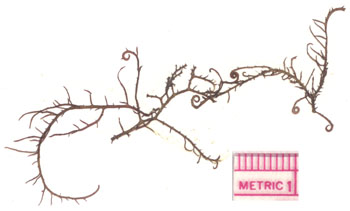Hookweed

Image Credit: www.botany.hawaii.edu
Hookweed (Hypnea musciformis)
Hawaii Pacific Weed Risk Assessment: None
Regulatory Status: None
Prevention and Control Category: None
Description
-
Reddish or brownish seaweed that has enlarged curls or “hooks” at the ends of some branches, allowing it to twine around other seaweeds.
-
Found on intertidal and shallow subtidal reef flats, tidepools, and rocky benches
-
Tends to grow on other large seaweeds such as Sargassum (limu kala)
-
May be free floating is shallow waters
-
Introduced from Florida to Kaneohe Bay in 1974 for aquaculture research to produce carrageenan
Impacts
-
Spreads mainly by fragmentation: the “hooks” anchor the hookweed to other seaweed or the reef bottom. Wave action breaks off most of the hookweed, which drifts until it is able to latch onto another location. Even the smallest hooks will grow back until waves break it off again. Not yet observed to produce spores.
-
Grows faster and shades out coral and other seaweeds, changing reef ecosystem. Small pieces can increase its weight 200% in one week
-
Large amounts of hookweed wash ashore and decompose at some beaches. The large amounts of the seaweed, along with the smell and flies, decreases beach use and property value
-
Drifting rafts of seaweed deter ocean use in some areas
Distribution
-
Kauai: Present at Prince Kuhio Beach and Salt Pond Beach
-
Oahu: Present in large numbers at some locations such as Kahala, Waikiki, Ala Moana, Kahe and Makaha
-
Maui: Present in large amounts on many windward and leeward reefs. On some reefs in West Maui and Kihei, hookweed covers 80% of the reef
-
Molokai: Found at Kaunakakai, Kupepe, and other areas
-
Lanai: Presence/absence is unknown
-
Kahoolawe: Presence/absence is unknown
-
Big Island: Not known to be present at this time
-
hookweed has recently been found spreading on near-pristine reefs of Mokumanamana (Necker Island) in the Northwestern Hawaiian Islands
